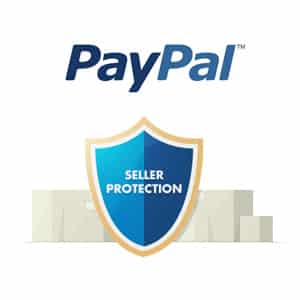If you’re selling an item using PayPal, for example, and your buyer has a problem with it, there are systems to protect you from false claims and chargebacks. This post’s goal is to help you know those protections. Tighten your seat belt for a ride on what is PayPal seller protection and its operation in the UK. To further explain, we shall also consider PayPal seller protection items not as described.
PayPal Seller Protection Overview
PayPal has become one of the most widely accepted payment methods for online purchases, behind only credit and debit cards. The vast majority of E-commerce merchants accept PayPal at checkout. And that level of reach means that PayPal has a great deal of responsibility when it comes to dealing fairly with both customers and merchants.
It does not, however, prevent consumers from disputing a transaction with their bank directly. In order to be eligible for PayPal Seller Protection, the seller must meet certain requirements. Such requirements include having proof of delivery for the purchase. If these requirements are met, PayPal will protect the seller from any costs associated with an “unauthorized payment” or “item not received” claim. It does not protect from other types of claims.
What is Paypal Seller Protection?
PayPal Seller Protection is a policy that can protect your transactions from chargebacks, reversals, and their associated fees. This means that if you sell something to a buyer, they dispute or reverse the transaction. You may be eligible to retain the full purchase amount and avoid any related chargeback fees paid (for debit and credit card-funded transactions).
What is Proof of Delivery?
For physical goods:
- Date of delivery and ‘delivered’ status
- An address for the recipient that matches the shipping address on the Transaction Details page
- An address for the recipient showing at least the city/state, city/country, or zip/postal code (or international equivalent).
- Signature confirmation when the full amount of the payment (including shipping and taxes) exceeds the amount (based on the currency of the payment) listed in the signature confirmation threshold table Signature confirmation is online documentation, viewable at the shipping company’s website, indicating that the item was signed for.
For Intangible goods:
In the case of intangible or digital goods, proof of shipment or delivery means compelling evidence to show the item was delivered or the purchase order was fulfilled. Compelling evidence could include a system of record showing the date the item was sent and that it was either:
- Electronically sent to the recipient, including the recipient’s address (email, IP, etc.), where applicable; or
- Received or accessed by the recipient.
For QR Code Transactions:
For QR code transactions, you may be required to provide us with alternative evidence of delivery or such additional documentation or information relating to the transaction.
PayPal Seller Protection UK
PayPal seller protection in the UK comes with many benefits because they know that protection is important to you when selling online and when you deliver on your service promises. It will protect you from abusive buyer behavior and from events outside your control. For that to be accomplished they asked all sellers to :
- Honor all of their service promises
- Report abusive activity so we can take action to protect you and other sellers
- Remain courteous and professional when dealing with buyers
Let’s consider some of the Paypal seller protection UK and the benefits that fall under them.
Abusive Buyer Detection, Enforcement, and Protection
- Paypal has a strong Abusive Buyer policy that defines buyer abuse and allows us to take action on abusive buyers Abusive buyer policy.
- You’ll find the Report a Buyer functionality both in the returns flow and in the Resolutions center. This will take you to the Resolutions center which allows sellers to report abusive buyers so we can take action on them.
- Improved abusive buyer actions: when we find a buyer is abusive we’ll warn them, we won’t facilitate them sending returns, or we’ll suspend their account.
- We have automatic feedback and defect removal when we find a buyer has violated the new abusive buyer policy.
- Feedback and defect removal when you can cancel a transaction because a buyer demands something not offered in the original listing.
- Feedback and defect removal when a buyer retracts their bid or doesn’t pay.
Protection if a Buyer Doesn’t Pay
This similar PayPal seller protection item is not as described. However, If the buyers don’t pay straight away, it could just be that they are inexperienced or are having problems with their electronic payment system. Our detection methods help us identify high-risk buyers who might be bidding on or purchasing several similar items at once. If this happens, we’ll take action before the transaction takes place.
- We identify buyers that haven’t paid so we can automatically remove any negative or neutral Feedback they leave for you.
- When an unpaid item case closes without payment, we’ll block the buyer from leaving Feedback and take action on their account.
- You can use our Unpaid item assistant to automate the opening and closing of unpaid item cases in our Resolution Centre.
What are the PayPal time limits?
A buyer must open a dispute via the PayPal Resolution Centre within 180 days of making the payment. This is an extension of the 45 days that it was previously.
If a resolution can’t be found, the buyer can escalate the complaint but only within 20 days of opening the dispute. Otherwise, PayPal will close the dispute and the buyer won’t be eligible for reimbursement.
During the claims process, PayPal may require documentation to support your position, such as proof of postage and delivery.
Once a dispute escalates, PayPal will survey the evidence and make a decision in favor of the buyer or seller.
If you’ve followed all the requirements for your sale to be eligible for PayPal Seller Protection, it’s unlikely that you’ll lose out.
Are Sellers Protected with PayPal Friends and Family?
If you are a creator and you take payment from your brand partners in exchange for your material and services, then according to PayPal’s acceptable usage policy, you are a “seller.” When operating as sellers, creators should never agree to accept payment from their brand partners through the “friends and family” option provided by PayPal.
How Do I Get Sued for PayPal?
There is a possibility that you may file a claim against PayPal in a local small claims court. Make it a point to read over any and all terms that PayPal has sent your way (here is the contract of carriage for PayPal, make sure it applies to you). Even if there can be a mandatory arbitration clause, the majority of the time there is a loophole for smaller claims court cases.
Paypal Seller Protection Item not as described
It’s a situation none of us wants to deal with, but most of us will have to sooner or later. You buy a product online, and it arrives damaged. or the wrong color. Maybe it simply doesn’t work, or the description doesn’t match the product. All of the above are examples of PayPal seller protection items not as described.
What do you do?
If you bought the product through PayPal, you do have options, but you’re going to have to be patient. The basic steps are laid out on PayPal’s Help page for what to do if you didn’t receive your item or if it’s different than was described. Let us go through them in a moment.
- First, go to PayPal’s Resolution Center. Click on “Report a Problem” to open what the company calls a dispute. You have 180 days from when you first made the transaction to do this.
- Once you’ve opened a dispute, you have 20 days to contact the seller through PayPal to see if the problem can be resolved that way
- If you can’t solve the problem (or you never hear back from the seller), go back to the Resolution Center, find the listed entry for your dispute, and click “View” > “Escalate to PayPal.” Now the dispute has formally become a claim.
- PayPal will begin investigating the claim and will email you updates as to the status of its investigation. If it finds that your claim is legitimate, you’ll get a refund to your PayPal account.
According to PayPal, it usually takes about 30 days for a claim of PayPal seller protection; the item is not as described, although it can take longer. You can go to the Resolution Center to see if anything’s happening.
Will PayPal Cover Me if I Get Scammed, Seller?
The Buyer Protection policy applies to all qualifying online purchases made using PayPal, in addition to payments processed through our own website. In order to take advantage of Buyer Protection, among other things, we require that accounts be kept in good standing and ask that a dispute be submitted within 180 days of your purchase or payment. This is because we want to ensure that you have the best possible experience while shopping with us.
How Does PayPal Decide Who Wins a Dispute?
PayPal will investigate the claim, collect information from both the buyer and the seller, and then make a final decision regarding whether or not the transaction should be reversed. PayPal will immediately open a claim rather than beginning with a dispute in the event that a buyer alleges that the purchase was made using fraudulent means.
What Does the Seller Protection Policy Not Cover?
As long as the transactions satisfy these conditions, the vast majority of PayPal transactions are protected. However, there are several situations in which Seller Protection is not applicable, including the following: Claims, chargebacks, or reversals submitted because the item is significantly different from how it was represented (for example, you described an item as “new,” but sent a used one). Claims, chargebacks, or reversals are filed because the item is significantly different from how it was described.
What Happens to Seller PayPal Dispute?
In the event that a claim is made, the seller is required to provide a response within ten days. If the seller does not answer within a reasonable amount of time, the claim will be considered resolved in the buyer’s favor, and they will be given a full refund. In the event that the seller does offer a response, PayPal will work to examine the information that was supplied and decide the outcome of the claim.
How do I deal with PayPal disputes and chargebacks?
It’s in your interest to cooperate with PayPal if a buyer raises a dispute or attempts a chargeback.
Disputes
As you’re dealing directly with the buyer, you should ask them for photos of the product they received.
If it appears the buyer is correct, you should apologize and correct the situation by sending another or giving a refund.
If you think the buyer is wrong, the dispute could be escalated to a claim after 20 days and PayPal will step in and investigate. At this point, you will no longer be able to communicate with the buyer directly.
Again, cooperating with PayPal is in your interest, and having lots of evidence will help your case.
Chargeback
A buyer may choose to file a chargeback through their bank or card provider. When this happens, money will be taken from your account while the buyer’s bank or card provider decides if their claim is valid. But you still might be covered by PayPal Seller Protection. Like in a dispute, you will need to provide evidence to show why the chargeback isn’t valid.
Credit card chargeback rights may be broader than PayPal’s terms and conditions. If a buyer has opened a claim with PayPal and they then file a chargeback, PayPal will close their claim and the buyer will have to rely on chargeback rights.
FAQ
Can a seller get scammed on PayPal?
Sometimes, a scammer may make a payment to a seller’s PayPal account that exceeds the cost of the item they are purchasing.
Does PayPal refund stolen money?
Any transaction found to be in error or unauthorized will be refunded
Can I get my PayPal account back?
Once you close your PayPal account, it cannot be reopened. You can open a new account, but it won’t include your previous transaction history.






